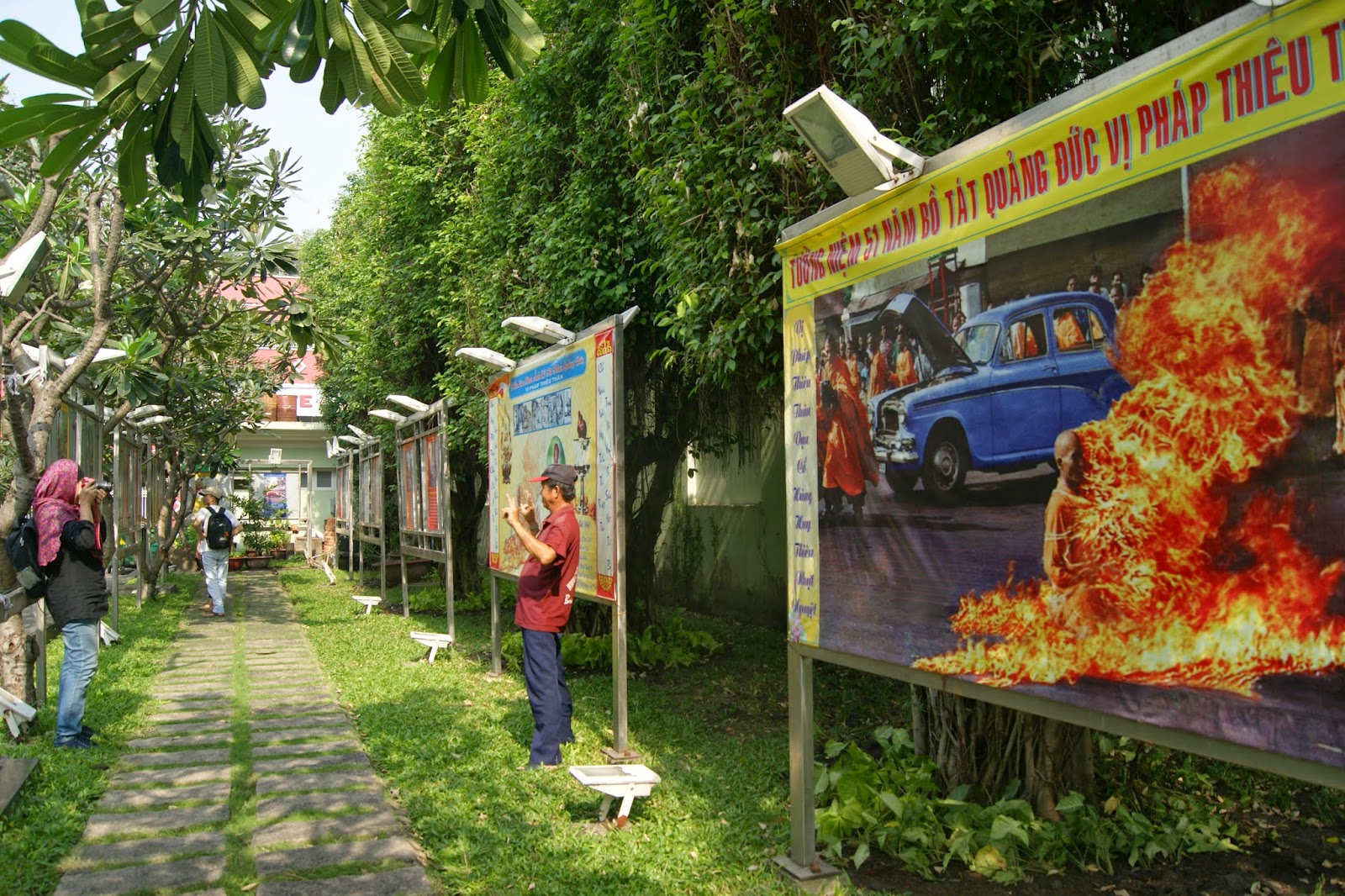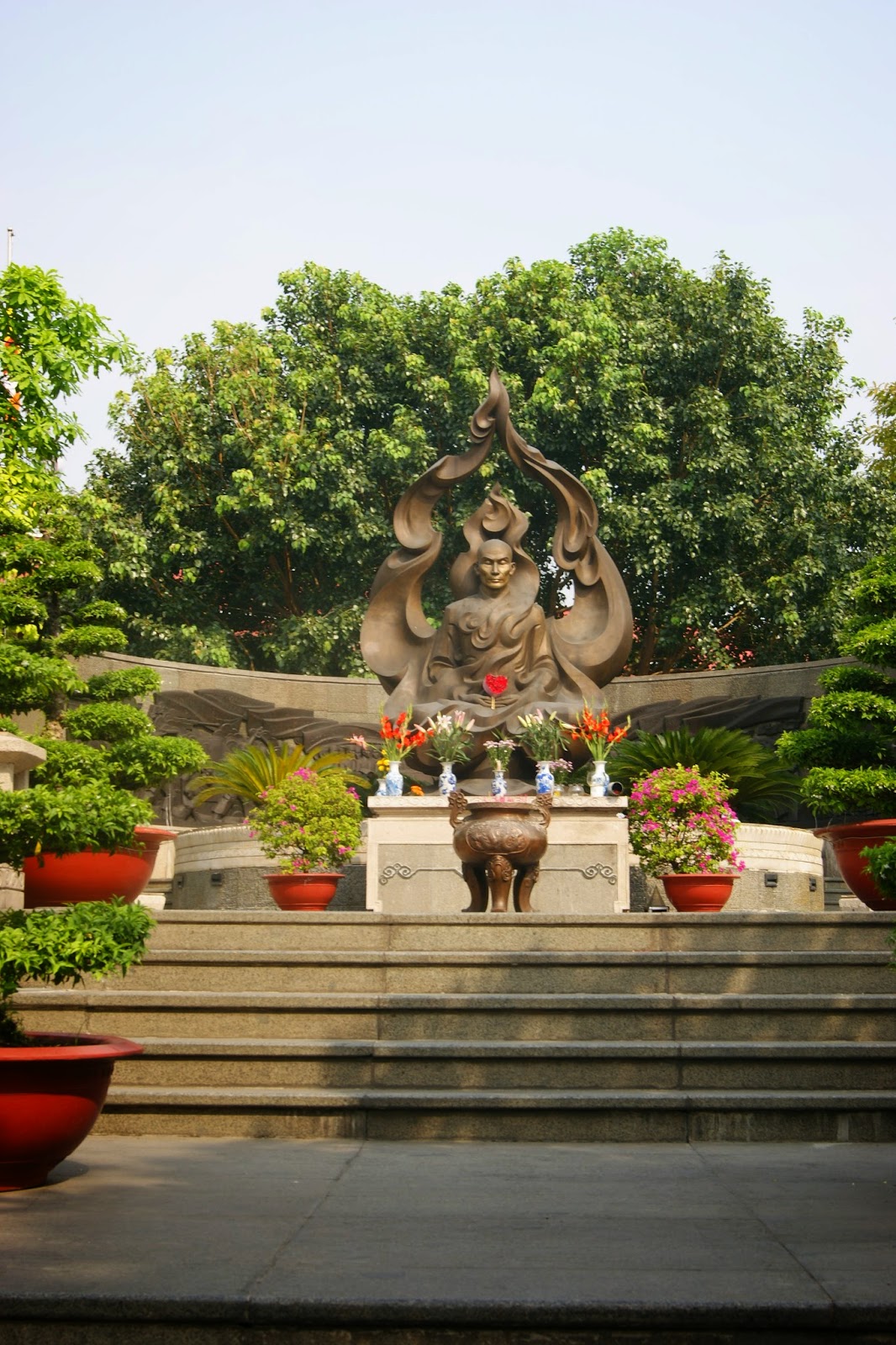Date of visit: 30th December 2014
The cyclo driver
allowed us to have our photo shoot session at where the monument to remember Thic Guang Duc is
located after seeing how hard I focused my lenses to snap a sharper image from a
far distance. He even tried to explain what the place are about. Knowing that
he failed to do so, he took me to read what was written on the monument stone
and the big banner about the plight of Thich Guang Duc and his followers.
Thich Quang Duc,
born in 1897, was a Vietnamese Mahayana Buddhist monk who burned himself to
death at a busy Saigon road intersection on 11 June 1963 (where the monument
was located). He was protesting the persecution of Buddhists by the South
Vietnamese government led by the then dictator, Ngo Dinh Diem. Photographs of
his self-immolation were circulated widely across the world and brought
attention to the policies of the Diem government. Journalist Malcolm Browne's
photograph of Quang Duc during his self-immolation has won the 1963 World Press
Photo of the Year, a Pulitzer Prize. John F. Kennedy said in reference to a
photograph of Duc on fire, "No news picture in history has generated so
much emotion around the world as that one”.
Later on, Quang
Duc's act increased international pressure on Diem leading him to announce
reforms with the intention of mollifying the Buddhists. However, the promised
reforms were not implemented, it led the dispute to deteriorate further. With
protests continuing, the ARVN Special Forces loyal to Diem's brother, Ngo Dinh
Nhu, launched nationwide raids on Buddhist pagodas, seizing Quang Duc's heart
and causing deaths and widespread damage. Several Buddhist monks followed Quang
Duc's example, also immolating themselves. In the end, an Army coup toppled Diem,
who was assassinated on 2 November 1963, 5 months after Thich Guang Duc heroic
moves.
Despite the
shock of the Western public, the practice of Vietnamese monks self-immolating
was not unprecedented. Instances of self-immolations in Vietnam had been recorded
for centuries, usually carried out to honor Gautama Buddha. The most recently
recorded case had been in North Vietnam in 1950. The French colonial
authorities had tried to eradicate the practice after their conquest of Vietnam
in the 19th, but had not been totally successful. They did manage to
prevent one monk from setting fire to himself in Hue in the 1920s, but he
managed to starve himself to death instead. During the 1920s and 1930s, Saigon
newspapers reported multiple instances of self-immolations by monks in a
matter-of-fact style. The practice had also been seen in the Chinese city of
Harbin in 1948 when a monk seated down in the lotus position on a pile of
sawdust and soybean oil and set fire to himself in protest against the treatment
of Buddhism by the communists of Mao Zedong. His heart remained intact, as did
that of Quang Duc.
For the record,
Islam prohibited this kind of act, as what beliefs and written in the Quran as well asin the other Holy Book, Torah and Bible.
The body was
re-cremated during the funeral, but Quang Duc's heart remained intact and did
not burn. It was considered to be holy and placed in a glass chalice at Xa Loi
Pagoda. The intact heart relic is regarded as a symbol of compassion. Duc has
subsequently been revered by Vietnamese Buddhists as a bodhisattva. During the ARVN
Special Forces of Nhu’s attacked to all Buddhist pagodas across Vietnam, they have
intended to confiscate Quang Duc's ashes, but two monks had escaped with the
urn, jumping over the back fence and finding safety at the U.S. Operations
Mission next door. However the special police managed to confiscate Quang Duc’s
charred heart.
Remarks: A bodhisattva is an ordinary person who takes
up a course in his or her life that moves in the direction of Buddha. Actually,
anyone who directs their attention, their life, to practicing the way of life
of a buddha is a bodhisattva.
The location chosen for the self-immolation, in
front of the Cambodian embassy, raised questions as to whether it was
coincidence or a symbolic choice. Trueheart and embassy official Charles
Flowerree felt that the location was selected to show solidarity with the
Cambodian government of Prince Norodom Sihanouk. South Vietnam and Cambodia had
strained relations. Prince Norodom Sihanouk in his speech had openly accused Diem
of mistreating Vietnamese and ethnic minority Khmer Buddhists.
Source of info: Wikipedia












No comments:
Post a Comment